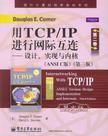用TCP/IP进行网际互连第二卷
2009-8
电子工业出版社
(美)科默,(美)史蒂文 著
660
无
本书是关于计算机网络的经典教材,是目前美国大多数大学所开设的计算机网络课程的主要参考书。全书共三卷。第二卷在第一卷介绍了TCP/IP基本概念的基础上,进一步详细讨论了TCP/IP的实现细节。这一卷的突出特点 非常注重实际。作者利用程序代码实现了TCP/IP的每个技术细节,并且所有代码在书中均可找到,有助于读者深入了解并掌握TCP/IP的细节内容。书中附录分别给出了过程调用交叉参考表、程序代码中用到的C数据结构交叉参考表及Xinu函数和常量。
Douglas E.Comer:普度大学的一位杰出的计算机科学教授,思科系统公司的访问教授成员,并且是计算机网络和TCP/IP以及因特网方面的国际公认的专家。他的著作已翻译成16种语言,并广泛用于世界各地的工业界和学术界。作为他的得意之作,这套共分三卷的《用TcP/IP进行网际互连》彻底改变了组网和网络方面的教育,并且他的不断创新的工作继续影响着研究生和大学生所学的课程。作为美国计算机学会的会士,在他获得的许多荣誉中包括Usenix终生成就奖。
ForewordPrefaceChapter 1 Introduction And Overview 1.1 TCP/IP Protocols 1.2 The Need To Understand Details 1.3 Complexity Of Interactions Among Protocols 1,4 The Approach In This Text 1.5 The Importance Of Studying Code 1.6 The Xinu Operating System 1.7 Organization Of The Remainder Of The Book 1.8 Summary Chapter 2 The Structure Of TCP/IP Software In An Operating System 2.1 Introduction 2.2 The Process Concept 2.3 Process Priority 2.4 Process Synchronization 2.5 lnterprocess Communication 2.6 Device Drivers, Input, And Output 2.7 Network Input and Interrupts 2.8 Passing Packets To Higher Level Protocols 2.9 Passing Datagrams From IP To Transport Protocols 2.10 Delivery To Application Programs 2.11 Information Flow On Output 2.12 From TCP Through IP To Network Output 2.13 UDP Output 2.14 Summary Chapter 3 Network Interface Layer 3.1 Introduction 3.2 The Network Interface Abstraction 3.3 Ethernet Definitions 3.4 Logical State Of An Interface 3.5 Local Host Interface 3.6 Buffer Management 3.7 Demultiplexing Incoming Packets 3.8 SummaryChapter 4 Address Discovery And Binding (ARP) 4.1 Introduction 4.2 Conceptual Organization Of ARP Software 4.3 Example ARP Design 4.4 Data Structures For The ARP Cache 4.5 ARP Output Processing 4.6 ARP Input Processing 4.7 ARP Cache Management 4.8 ARP Initialization 4.9 ARP Configuration Parameters 4.10 Summary Chapter 5 IP: Global Software Organization 5.1 Introduction 5.2 The Central Switch 5.3 IP Software Design 5.4 IP Software Organization And Datagram Flow 5.5 Byte-Ordering In The IP Header 5.6 Sending A Datagram To IP 5.7 Table Maintenance 5.8 Summary Chapter 6 IP: Routing Table And Routing Algorithm 6.1 Introduction 6.2 Route Maintenance And Lookup 6.3 Routing Table Organization 6.4 Routing Table Data Structures 6.5 Origin Of Routes And Persistence 6.6 Routing A Datagram 6.7 Periodic Routing Table Maintenance 6.8 IP Options Processing 6.9 Summary Chapter 7 IP: Fragmentation And Reessembly 7.1 Introduction 109 7.2 Fragmenting Datagrams 7.3 Implementation Of Fragmentation 7.4 Datagram Reassembly 7.5 Maintenance Of Fragment Lists 7.6 Initialization 7.7 Summary Chapter 8 IP: Error Processing (ICMP) 8.1 Introduction 8.2 ICMP Message Formats 8.3 Implementation Of ICMP Messages 8.4 Handling Incoming ICMP Messages 8.5 Handling An ICMP Redirect Message 8.6 Setting A Subnet Mask 8.7 Choosing A Source Address For An ICMP Packet 8.8 Generating ICMP Error Messages 8.9 Avoiding Errors About Errors 8.10 Allocating A Buffer For ICMP 8.11 The Data Portion Of An ICMP Message 8.12 Generating An ICMP Redirect Message 8.13 Summary Chapter 9 IP: Multicast Processing (IGMP) 9.1 Introduction 9.2 Maintaining Multicast Group Membership Information 9.3 A Host Group Table 9.4 Searching For A Host Group 9.5 Adding A Host Group Entry To The Table 9.6 Configuring The Network Interface For A Multicast Address 9.7 Translation Between IP and Hardware Multicast Addresses 9.8 Removing A Multicast Address From The Host Group Table 9.9 Joining A Host Group 9.10 Maintaining Contact With A Multicast Router 9.11 Implementing IGMP Membership Reports 9.12 Computing A Random Delay 9.13 A Process To Send IGMP Reports 9.14 Handling Incoming IGMP Messages 9.15 Leaving A Host Group 9.16 Initialization Of IGMP Data Structures 9.17 Summary Chapter 10 UDP: User Datagrams 10.1 Introduction 10.2 UDP Ports And Demultiplexing 10.3 UDP Input Processing 10.4 UDP Output Processing 10.5 Summary Chapter 11 TCP: Data Structures And Input Processing 11.1 Introduction 11.2 Overview Of TCP Software 11.3 Transmission Control Blocks 11.4 TCP Segment Format 11.5 Sequence Space Comparison 11.6 TCP Finite State Machine 11.7 Example State Transition 11.8 Declaration Of The Finite State Machine 11.9 TCB Allocation And Initialization 11.10 Implementation Of The Finite State Machine 11.11 Handling An Input Segment Chapter 12 TCP: Finite State Machine Implementation 12.1 Introduction 12.2 CLOSED State Processing 12.3 Graceful Shutdown 12.4 Timed Delay After Closing 12.5 TIME-WAIT State Processing 12.6 CLOSING State Processing 12.7 FIN- WAIT-2 State Processing 12.8 FIN-WAlT-1 State Processing 12.9 CLOSE-WAIT State Processing 12.10 LAST-ACK State Processing 12.11 ESTABLISHED State Processing 12.12 Processing Urgent Data In A Segment 12.13 Processing Other Data In A Segment 12.14 Keeping Track Of Received Octets 12.15 Aborting A TCP Connection 12.16 Establishing A TCP Connection 12.17 Initializing A TCB 12.18 SYN-SENT State Processing 12.19 SYN-RECEIVED State Processing 12.20 LISTEN State Processing 12.21 Initializing Window Variables For A New TCB 12.22 Summary Chapter 13 TCP: Output Processing 13.1 Introduction 13.2 Controlling TCP Output Complexity 13.3 The Four TCP Output States 13.4 TCP Output As A Process 13.5 TCP Output Messages 13.6 Encoding Output States And TCB Numbers 13.7 Implementation Of The TCP Output Process 13.8 Mutual Exclusion 13.9 Implementation Of The IDLE State 13.10 Implementation Of The PERSIST State 13.11 Implementation Of The TRANSMIT State 13.12 Implementation Of The RETRANSMIT State 13.13 Sending A Segment ……Chapter 14 TCP:Timer ManagementChapter 15 TCP:Flow Control And Adaptive RetransmissionChapter 16 TCP:Urgent Data Processing And The Push FuncionChapter 17 Socket-Level InterfaceChapter 18 RIP:Active Route Propagation And Passive AcqusitionChapter 19 OSPF:Route Propagation With An SPF AlgorithmChapter 20 SNMP:MIB Variables Representations And BindingsChapter 21 SNMP:Client And ServerChapter 22 SNMP:Table Access FunctionsChapter 23 Implementation In RetrospectAppendix1 Cross Reference Of Procedure CallsAppendix2 Cross Reference Of C Structures Used In The codeAppendix3 Xinu Functions And Constants Used In The CodeBibliographyIndex
《用TCP/IP进行网际互连第2卷:设计、实现与内核(ANSI C版)(第3版)(英文版)》一代又一代的专业技术人员}RDouglas Comer的《用TCP/IP进行网际互连》视为了解那些使因特网得以运转的协议和技术的敲门砖,它思路清晰,简单易懂。《用TCP/IP进行网际互连第2卷:设计、实现与内核(ANSI C版)(第3版)(英文版))》是其中的第二卷,作者深入探讨了TCP/IP的设计方案,考察了每个协议的具体细节及实现技术,并惹重介绍了协议软件的内部机制。贯穿全书的是一个利用ANSI C构建的可运行系统,用来讲解协议之间的交互操作、完整的实现过程及内部结构。《用TCP/IP进行网际互连第2卷:设计、实现与内核(ANSI C版)(第3版)(英文版)》主要特点:对一些协议的修改和更新,其中的代码已升级为ANSl标准C语言包含大多数协议的运行资源代码,包括TCP、IP、ICMP、IGMP、UDP、ARP、RIP、SNMP和OSPF的重要部分利用ANSI C定义了数据结构、常量及过程和进程的代码全面介绍了IETF设计的开放最短路径优先(OSPF)链路状态路由协议支持用于IP户组播的IGMP协议,以及用于音频和视频组播的OSPF路由协议讲解了紧急数据处理

无
书很正,指着它考试呢
还没怎么看,不过内容应该不错
对学习有帮助,一举两得
书的内容必然不错,至于书本身的质量,也算不错。。
书收下来以后发现有破损。。是我买了几十本书 第一次出现这种情况。买这本书后,我再也不敢完全信任网购书了。
入门好书,注重理论和基础,不要指望看懂这本书能成为网络编程的高手,但是很有用,告诉了读者解决问题的思路和方法
虽然较难,不过内容很好,值得多看。